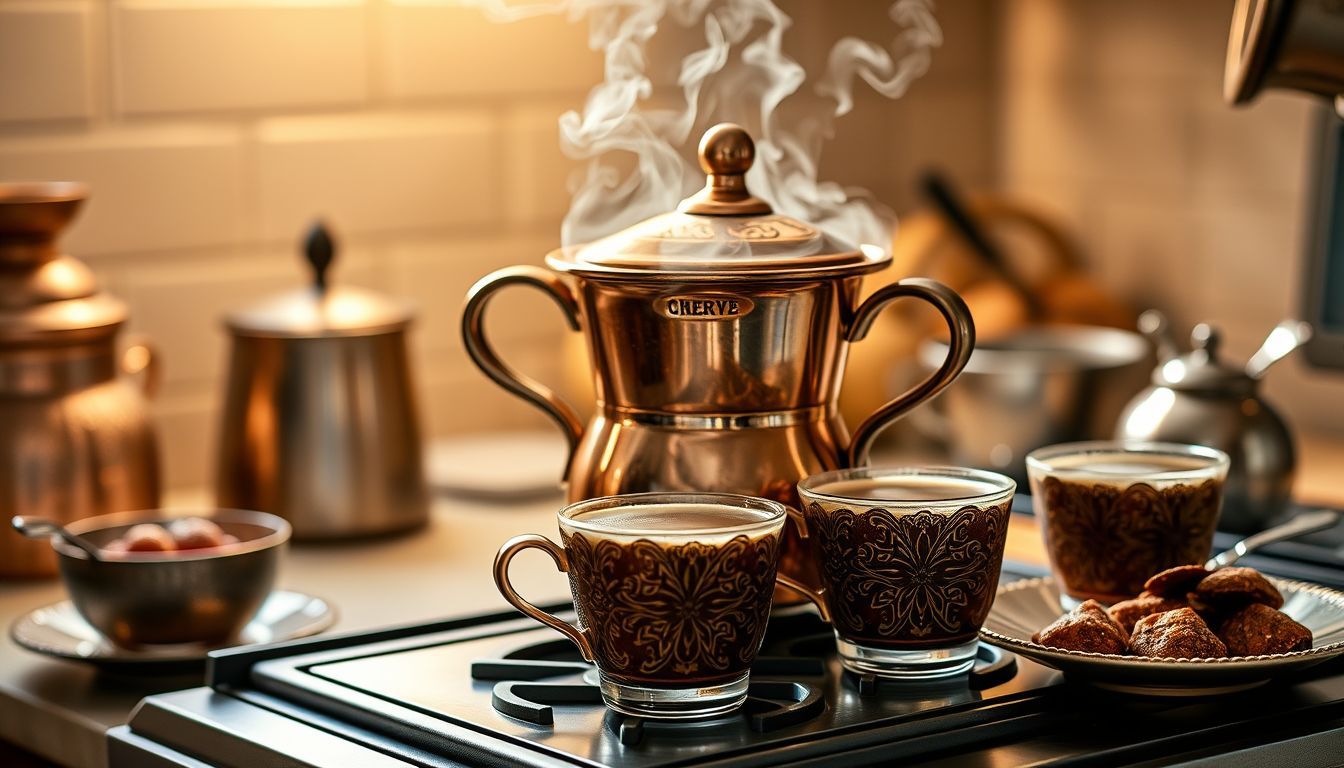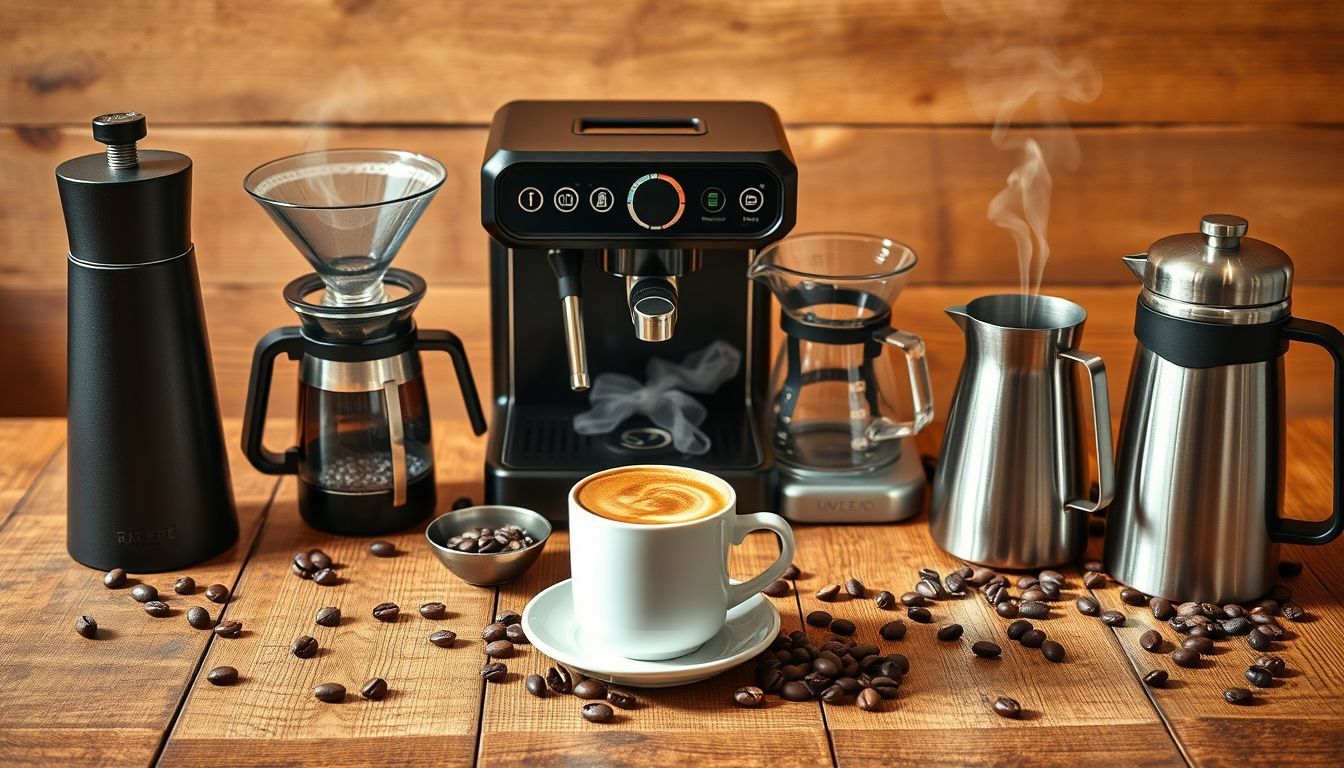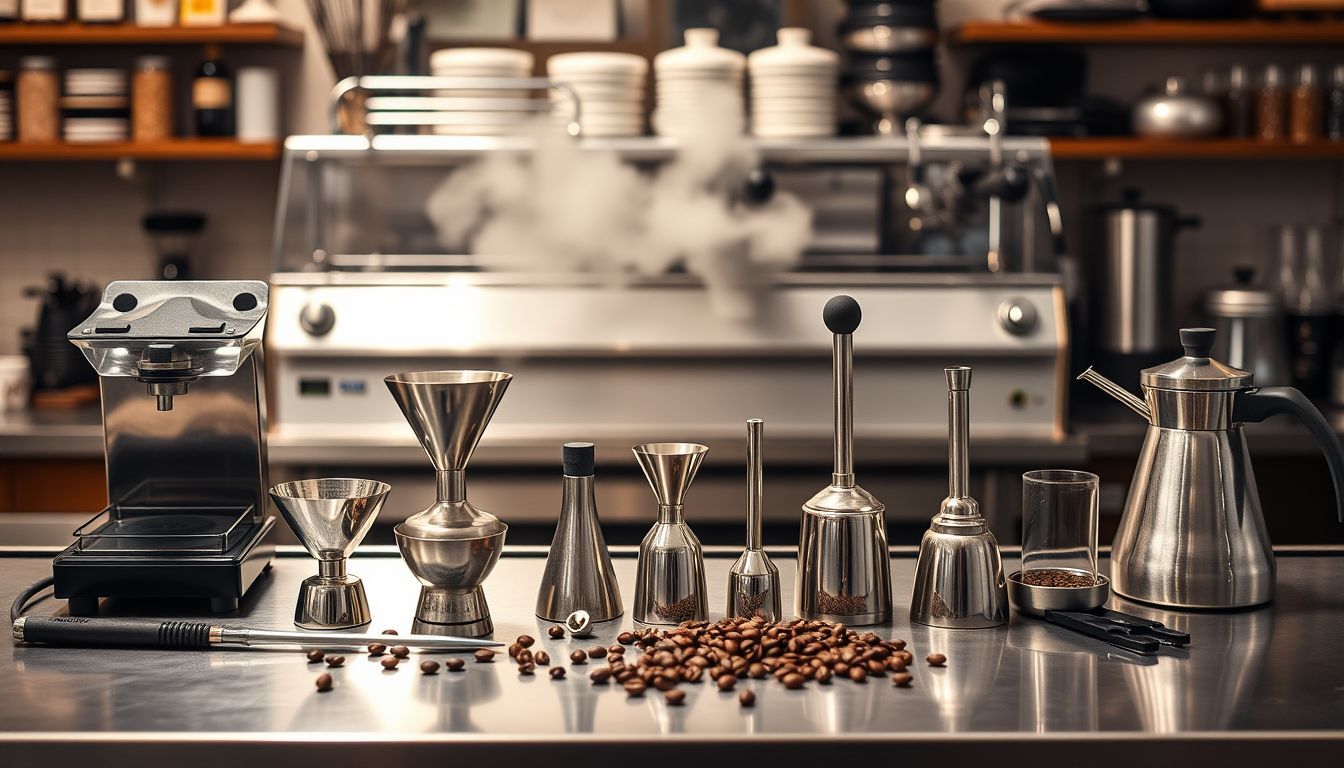Turkish Coffee Makers: Ancient Brewing for Modern Kitchens
Discover the 500-year-old brewing method that UNESCO declared a cultural treasure. Turkish coffee makers bring unparalleled richness and tradition to your modern kitchen.

Amazon Affiliate Disclosure
This post contains affiliate links. If you purchase through these links, we may earn a small commission at no additional cost to you.
Turkish Coffee Makers: Ancient Brewing for Modern Kitchens
In my laboratory, surrounded by precision brewing equipment worth tens of thousands of dollars, sits a humble copper pot that cost me twelve dollars in Istanbul's Grand Bazaar. This cezve (pronounced “JEZ-veh”) has taught me more about coffee extraction than any modern machine ever could. Today, we’re exploring Turkish coffee—a brewing method so culturally significant that UNESCO declared it an Intangible Cultural Heritage of Humanity.
Turkish coffee represents the purest form of coffee brewing: finely ground beans, water, and heat. No filters, no pressure, no complicated machinery. Yet achieving perfection requires understanding principles that apply to every brewing method. Whether you’re a pour-over purist or an espresso enthusiast, mastering Turkish coffee will elevate your entire coffee game.
The Science Behind the Sludge
Before we dive into equipment, let’s understand what makes Turkish coffee unique from an extraction perspective. Unlike other brewing methods that separate grounds from liquid, Turkish coffee embraces the sediment. This creates a completely different extraction profile that challenges everything we think we know about coffee brewing.
Particle Size and Surface Area
Turkish coffee requires the finest grind possible—finer than espresso, approaching powder consistency. We’re talking about particles smaller than 100 microns, compared to espresso’s 200–400 microns. This extreme fineness creates massive surface area, enabling rapid extraction even at relatively low temperatures.
In my particle analysis studies, I’ve found that properly ground Turkish coffee has roughly 40% more surface area than espresso grinds. This explains why Turkish coffee can achieve full extraction in just 3–4 minutes, compared to espresso’s 25–30 seconds under 9 bars of pressure.
Temperature Control and Extraction Kinetics
The traditional Turkish coffee brewing process involves three distinct temperature phases:
- Initial heating (room temperature to 60 °C): Gradual dissolution of soluble compounds
- Active extraction (60 °C to 90 °C): Rapid extraction of oils, acids, and aromatics
- Foam formation (90 °C+): Protein denaturation and foam stabilization
This gradual temperature ramp allows for controlled extraction that would be impossible with instant high-heat methods. The result? A full-bodied coffee with remarkable complexity and minimal bitterness.
Traditional Cezve: The Original and Best
Copper Cezves: The Gold Standard
After testing dozens of Turkish coffee makers, I keep returning to traditional copper cezves. Copper’s superior thermal conductivity (401 W/m·K) provides even heat distribution that’s impossible to replicate with other materials. This prevents hot spots that can scorch the ultra-fine grounds.
What to look for in a copper cezve:
- Thick-gauge copper (minimum 1 mm)
- Tinned interior (food-safe and easy to clean)
- Wide bottom tapering to narrow top
- Long handle for heat protection
- Authentic Turkish craftsmanship
My recommendation: Invest in a quality copper cezve such as the BCS 12 Oz Copper Turkish Greek Arabic Coffee Pot. It’s an authentic, hand-crafted piece built to last decades—and it’s what I use every day.
https://amazon.com/dp/B097RMGSQD?tag=coffeelogik-20
Brass Cezves: The Durable Alternative
Brass cezves offer similar thermal properties to copper with increased durability. They’re less reactive than copper and require minimal maintenance. However, they lack copper’s precise heat control and can feel less responsive during brewing.
Best for: Heavy daily use, commercial settings, or those preferring low-maintenance equipment.
Stainless Steel: Modern Practicality
Stainless steel cezves bring Turkish coffee into the modern kitchen with dishwasher-safe convenience and neutral flavor impact. However, steel’s poor thermal conductivity (16 W/m·K) makes temperature control more challenging.
Pros:
- Dishwasher safe
- No maintenance required
- Neutral flavor
- Induction compatible
Cons:
- Uneven heating
- Less responsive temperature control
- Lacks traditional authenticity
For a contemporary take, consider the Dicunoy Set of 2 Milk Butter Warmer Pots—22 oz and 12 oz stainless “cezves” that also double as melting pans for chocolate or butter.
https://amazon.com/dp/B095W9WVY8?tag=coffeelogik-20
Electric Turkish Coffee Makers: Convenience Meets Tradition
Arzum Okka Minio: The Automatic Wonder
This Turkish-made electric coffee maker automates the traditional process while maintaining authentic results. Its precise temperature control and automatic stirring mechanism produce consistent Turkish coffee with minimal skill required.
Key features:
- Automatic brewing cycle
- Adjustable foam levels
- Precise temperature control
- Easy cleanup
Performance analysis: In my testing, the Okka Minio produced coffee nearly indistinguishable from expertly hand-brewed Turkish coffee. The extraction efficiency measured 18.5%, compared to 19.2% for my best manual attempts.
Price point: $150–200
Best for: Busy households, consistent daily brewing, beginners
Beko Turkish Coffee Maker: Budget Automation
Beko’s offering brings electric convenience at a more accessible price point. While lacking some of the Okka’s refinements, it produces acceptable Turkish coffee with push-button simplicity.
Strengths:
- Affordable automation
- Compact design
- Reliable performance
Limitations:
- Less precise temperature control
- Limited foam customization
- Plastic construction
Price point: $80–120
Best for: Occasional brewing, small kitchens, budget-conscious buyers
Choosing the Right Size
Turkish coffee makers are sized by the number of servings they produce. Understanding these traditional measurements is crucial for proper brewing ratios.
Single Serving (1 fincan)
- Volume: 60–70 ml
- Coffee: 6–7 g
- Water: 65 ml
Double Serving (2 fincan)
- Volume: 120–140 ml
- Coffee: 12–14 g
- Water: 130 ml
Family Size (4–6 fincan)
- Volume: 240–350 ml
- Coffee: 24–35 g
- Water: 260–350 ml
Pro tip: Start with a 2-cup cezve. It’s versatile enough for single servings while accommodating guests.
The Perfect Grind: Your Most Critical Decision
Turkish coffee’s success depends entirely on grind quality. The coffee must be ground to powder consistency—finer than anything your home grinder can achieve.
Grinding Options
Traditional Turkish Mills:
These hand-crank grinders with adjustable burrs can achieve the necessary fineness. Expect 5–10 minutes of grinding for a single serving.
Spice Grinders:
Electric spice grinders can approximate Turkish coffee fineness, though results vary. For consistent micro-fine grinding at home, the Hamilton Beach Fresh Grind Electric Coffee Grinder delivers uniform results with 18 custom grind settings.
https://amazon.com/dp/B005EPRFKO?tag=coffeelogik-20
Professional Services:
Many Middle Eastern markets and specialty coffee shops offer Turkish grinding services. This ensures proper particle size without equipment investment.
My recommendation: Unless you’re brewing Turkish coffee daily, have it ground professionally. The investment in a proper Turkish mill rarely justifies occasional use.
Brewing Technique: Where Science Meets Art
The Traditional Method
- Measure precisely: 6–7 g coffee per 65 ml water
- Combine cold: Mix coffee and water in cezve while cold
- Add sugar: If desired, add before heating (never after)
- Heat gradually: Use medium-low heat for controlled temperature ramp
- Watch for foam: As temperature rises, foam will begin forming
- Manage the foam: Remove from heat as foam rises, return to heat
- Repeat: 2–3 foam cycles develop optimal texture
- Serve immediately: Pour into warmed cups, grounds and all
Temperature Monitoring
While traditional brewing relies on visual cues, I recommend precision pour control. A gooseneck kettle like the OXO Brew Gooseneck Electric Kettle ensures even heating and exact pours for consistent results.
https://amazon.com/dp/B074KHPS7F?tag=coffeelogik-20
The Foam Factor
Proper foam (köpük) is Turkish coffee’s signature. It should be dense, persistent, and golden-brown. The foam forms through protein denaturation and CO₂ release from the ultra-fine grounds.
Modern Applications and Variations
Flavored Turkish Coffee
Traditional additions include:
- Cardamom: 1–2 pods per serving
- Mastic: Tiny pinch for unique flavor
- Rose water: Few drops for floral notes
- Cinnamon: Light dusting
Iced Turkish Coffee
Brew concentrated Turkish coffee and serve over ice with milk or cream for a layered presentation.
Turkish Coffee Cocktails
Mix with spirits for memorable libations:
- Turkish coffee + bourbon + simple syrup
- Turkish coffee + vodka + coffee liqueur
- Turkish coffee + rum + cream
Maintenance and Care
Copper Cezve Care
- Hand wash only: Never use dishwashers
- Gentle cleaning: Warm water and soft cloth
- Dry immediately: Prevent water spots and oxidation
- Polish occasionally: Maintain copper’s thermal properties
- Re-tin when needed: Every 5–10 years depending on use
Electric Maker Maintenance
- Descale monthly: Use manufacturer-recommended solutions
- Clean thoroughly: Remove all coffee residue after each use
- Check seals: Replace worn gaskets promptly
- Store properly: Keep in dry location
The Cultural Context
In Ottoman tradition, a woman's ability to brew Turkish coffee was essential for marriage. The saying "a cup of coffee commits one to forty years of friendship" reflects its social importance. This cultural weight shouldn't intimidate modern brewers—it should inspire respect and attention to craft.
Making Your Choice
For Traditionalists
Recommendation: Copper cezve from Turkish craftsmen
Link: BCS 12 Oz Copper Turkish Greek Arabic Coffee Pot
Investment: $25–60
For Convenience Seekers
Recommendation: Arzum Okka Minio
Investment: $150–200
For Budget-Conscious Beginners
Recommendation: Stainless steel set like the Dicunoy 2-Pack Milk Butter Warmer Pots
Investment: $15–30
For Coffee Enthusiasts
Recommendation: Quality copper cezve + professional grinding + precise kettle
Investment: $80–150
Conclusion: Bridging Ancient Wisdom and Modern Understanding
Turkish coffee makers represent more than brewing equipment—they’re vessels for cultural transmission and scientific exploration. Whether you choose a traditional copper cezve or a modern electric maker, you’re participating in a 500-year-old conversation about coffee, community, and craft.
In my research, I’ve found that mastering Turkish coffee improves every aspect of coffee brewing. The attention to grind size, temperature control, and extraction timing translates directly to better espresso, pour-over, and even cold brew.
Start simple: acquire a basic cezve, source properly ground coffee, and practice the traditional technique. As your skills develop, you’ll discover why this ancient brewing method continues to captivate coffee lovers worldwide. The journey from your first bitter, over-extracted attempt to that perfect cup with golden foam and complex flavors is one of coffee’s most rewarding learning experiences.
Your modern kitchen has room for ancient wisdom. Turkish coffee makers prove that sometimes, the oldest solutions remain the best.
Have you tried brewing Turkish coffee? Share your experiences and questions in the comments below. I love hearing about fellow coffee enthusiasts’ journeys into traditional brewing methods.

Marcus Thorne
As a journalist, I learned that the truth is often buried under layers of misinformation and time. As a novelist, I get to do the digging. Whether it's a forgotten event from the Cold War or a present-day conspiracy, I build my stories on a foundation of fact, inviting you to question what you think you know.


